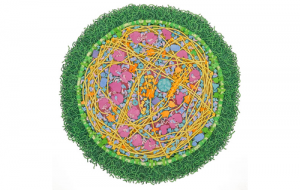“Magical, self-cleaning, water-repelling spray” is the description Aken Technologies has on its Kickstarter LiquidOff campaign page and a June 17, 2014 news item on Nanowerk offers more enthusiasm,
A new company with a revolutionary product likely to disrupt the clothing industry has launched a Kickstarter crowdfunding campaign to help get it off the ground.
Aken Technologies, LLC of Albuquerque, New Mexico is seeking to raise $25,000 for its LiquidOff product that uses innovative safe and eco-friendly nanotechnology to instantly make your clothing waterproof and self-cleaning.
The easy-to-use spray-on solution repels everything from wine spills to coffee and tea stains to barbeque sauce messes to mud splatters. And it’s not just for clothing. It’s just as effective for your shoes, car seats, tablecloths and furniture, and almost anything else you want to protect. It can be used on nearly all textiles and other surfaces such as leather, cotton, silk, suede, metal, plastic and paper.
A June 14, 2014 Aken Technologies news release, which originated the news item, describes more of the product benefits
LiquidOff is the first 100 percent green and eco-friendly solution that is not only chemical and aerosol free but also incorporates antimicrobial agents that protect against the transmission of microorganisms such as bacteria, viruses, and fungi.
For immediate and effective protection, you simply spray LiquidOff on the material and blow dry it or iron it. Alternatively, let the material dry for itself for a few hours. The treatment dries clear onto all surfaces and is completely invisible to the naked eye. It doesn’t leave a white cloudy haze like other products.
LiquidOff does hide the unsightly evidence of perspiration and maintains the breathability and texture of all treated materials. Garments will not be damaged, hardened, or become uncomfortable. Unlike existing products that can be toxic, LiquidOff’s proprietary trade-secret water-based formulation is completely safe, even for use on kids clothing.
LiquidOff is also “super hydrophobic.” It goes way beyond other hydrophobic liquid repellant products and its properties are much longer-lasting. Initial tests show that one treatment can provide over five years of protection. For areas that require constant washing, such as clothing, a treatment can last upwards of 20 washes.
LiquidOff is the brainchild of Aken Technologies’ CEO and founder, Harold Stewart, who recently left the security of his job as a Department of Defense electrical engineer to throw himself full-time into the business. Working with a scientific research team they brought nanotechnology out of the lab and applied it into a real world manufacturing solution.
Stewart said, “Our group has created a product that is truly unique and revolutionary. I like to say that LiquidOff is truly your knight in shining armor. As a company we are dedicated to providing advanced technology and innovative applications using the power of nanotechnology and its intrinsic properties in order to position ourselves as a leading edge nanotechnology solutions and applications provider.”
LiquidOff is the first of many unique and effective products that Aken Technologies intends to bring to market based on its cutting edge developments in nanotechnology. On Kickstarter the company is looking for contributions of as little as $5.00.
With 32 days left to achieve their goal of $25,000, Aken Technologies has raised a little over $15,000 which can be seen here. The campaign video is approximately 3 mins., 30 secs. and not only demonstrates previously mentioned product benefits, it reveals the product’s ability to enhance one’s dating prospects,
Set to a bouncy soundtrack, the video also features the product’s inventor/developer, Harold Stewart, discussing LiquidOff.
There does seem to be a company website at http://www.liquidoff.com but all of my attempts to access it lead me back to the Kickstarter campaign. I’m not sure what that means, if anything. In any event, I wish Harold Stewart and his partners good luck!
ETA June 25, 2014: Dexter Johnson asks some pointed questions about this campaign in his June 25, 2014 posting (Nanoclast blog on the IEEE [Institute of Electrical and Electronics Engineers] website),
The [Kickstarter] “investors” don’t really seem to be formulating the right questions. (Their questions are reasonable but not relevant to Aken’s prospects for success.) A typical question is something along the lines of: “Will this technology work?” Yes, it works; there’s been a long commercial history of hydrophobic materials being used effectively in textiles. Instead, what potential investors should be asking is how Aken’s offering is better than—or how can it even compete with—long-established companies that do the same.
